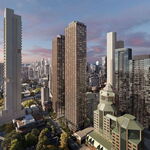A couple new articles on schools and real estate value on Realosophy.
Link:
http://www.movesmartly.com/2012/02/top-10-toronto-schools-for-2012.html
February 01, 2012
Best Toronto Schools 2012 (Realosophy Top Ten Neighbourhoods)
Urmi Desai in Top Ten Neighbourhoods, Home Buying, Toronto Neighbourhoods
It's school time at Realosophy Analytics! Our month-long feature looks at the special relationship between real estate and schools.
Today's post looks at the top elementary schools in Toronto as measured by the province's latest standardized EQAO scores.
While it's tempting to tape this school list to your goal wall/fridge/dreams and "make it so", it's important to remember that EQAO scores only tell us so much about school quality. For one, standardized testing results tend to favour advantaged socioeconomic groups, which can make the results more about 'who' attends than 'what' is being taught.
Educators also stress that some school strengths - like special curriculums or educational philosophies - fall outside testing parameters. But interestingly, specialty schools are a strong presence on our list. This is likely due to admissions requirements (e.g., for arts schools) and smaller class sizes.
Realosophy Workshop
Many of you have been in touch with specific real estate and schools questions - and we have lots more data and information to share. Sign up for our "Schools for Home Buyers" workshop on Sat Feb 25th (limited seating, first come first served). As part of the workshop, you'll receive a free Neighbourhood Match report which lists out the best Toronto neighbourhoods for your needs. Sign up below (scroll down to the end of this post).
The Data
•Overall score (in the bright yellow circle) represents an average of the six EQAO tests written by students in 2010-11 (reading, writing and math at the Gr. 3 and Gr. 6 levels)
•Covers all Toronto public schools (Note: some schools are too small to report EQAO results and are excluded)
•3 Year EQAO Increase represents an average of percentage points change from 2007-08 for all tests
•Average house prices for the neighbourhood in 2011
•3 Year increase in house prices from 2008 to 2011
1. Claude Watson School for the Arts
Neighbourhood: Willowdale
Grades: 1-8
Enrollment: 325
Address: 130 Doris Avenue
Average EQAO Test Score: 100%
3 Year EQAO Score Improvement: 4%
Average House Price: $488,344
3 Year Increase in House Prices: 30%
Browse detailed school scores and demographic data for Claude Watson
2. Hillmount Public School
Neighbourhood: Don Valley Village
Grades: JK-6
Enrollment: 251
Address: 1245 McNicoll Ave
Average EQAO Test Score: 98%
3 Year EQAO Score Improvement: 4%
Average House Price:$437,023
3 Year Increase in House Prices: 18%
Browse detailed school scores and demographic data for Hillmount Public School
3. St Michael's Choir (Jr) School
Neighbourhood: Yonge-Dundas Square
Grades: 1-8
Enrollment: 179
Address: 66 Bond St
Average EQAO Test Score: 98%
3 Year EQAO Score Improvement: 4%
Average House Price: $394,236
3 Year Increase in House Prices: 22%
Browse detailed school scores and demographic data for St Michael's Choir School
4. Cliffwood Public School
Neighbourhood: Don Valley Village
Grades: JK-6
Enrollment: 326
Address: 140 Cliffwood Rd
Average EQAO Test Score: 97%
3 Year EQAO Score Improvement: 11%
Average House Price: $437,023
3 Year Increase in House Prices: 18%
Browse detailed school scores and demographic data for Cliffwood Public School
5. Courcelette Public School
Neighbourhood: Birchcliff
Grades: JK-8
Enrollment: 265
Address: 100 Fallingbrook Rd
Average EQAO Test Score: 96%
3 Year EQAO Score Improvement: 8%
House Price Average: $512,437
3 Year Increase in House Prices: 11%
Browse detailed school scores and demographic data for Courcelette Public School
6. Cottingham Junior Public School
Neighbourhood: Summerhill
Grades: JK-6
Enrollment: 121
Address: 85 Birch Avenue
Average EQAO Test Score: 96%
3 Year EQAO Score Improvement: 1%
Average House Price: $1,023,072
3 Year Increase in House Prices: 9%
Browse detailed school scores and demographic data for Cottingham Junior Public School
7. Blythwood Junior Public School
Neighbourhood: Lawrence Park
Grades: JK-6
Enrollment: 320
Address: 2 Strathgoway Cres
Average EQAO Test Score: 94%
3 Year EQAO Score Improvement: 0%
Average House Price: $2,129,108
3 Year Increase in House Prices: 14%
Browse detailed school scores and demographic data for Blythwood Junior Public School
8. John Ross Robertson Junior Public School
Neighbourhood: Lytton Park
Grades: JK-6
Enrollment: 561
Address: 130 Glengrove Avenue
Average EQAO Test Score: 94%
3 Year EQAO Score Improvement: 2%
Average House Price: $1,115,368
3 Year Increase in House Prices: 10%
Browse detailed school scores and demographic data for John Ross Robertson Junior Public School
9. Our Lady of Perpetual Help Catholic School
Neighbourhood: Moore Park
Grades: JK-8
Enrollment: 317
Address: 1 1/2 Garfield Avenue
Average EQAO Test Score: 94%
3 Year EQAO Score Improvement: 1%
Average House Price: $1,522,254
3 Year Increase in House Prices: 11%
Browse detailed school scores and demographic data for Our Lady of Perpetual Help Catholic School
10. Avondale Alternative Elementary School
Neighbourhood: Willowdale
Grades: JK-8
Enrollment: 113
Address: 171 Avondale Avenue
Average EQAO Test Score: 96%
3 Year EQAO Score Improvement: N/A
Average House Price: $488,344
3 Year Increase in House Prices: 30%
Browse detailed school scores and demographic data for Avondale Alternative Elementary School
~~~




